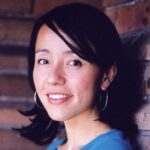In frightening times, it strikes me that we need art and literature (and meditation) all the more, to pull us back from the anxious onslaught of mass culture. Reading is an act of intimacy and contemplation, which allows for a different time orientation. As Susan Sontag, the consummate disaster witness, put it: the abandonment of literature and its “soul effects,” means “nothing less than the death of inwardness.”
It’s one day after the Tohoku earthquake and tsunami. I am at the Zen Poetry Festival in Montreal, browsing through the book selection, when Kazuaki Tanahashi arrives for a calligraphy demonstration. He takes a seat on the floor in front of a low table, which has been prepared with paper, brush and ink. The gathering audience is invited to call out words to be translated into kanji. Someone suggests “Love.” Another person calls out “Peace.” Next come “Emptiness” and “Compassion.” Then someone says, “Tsunami”. At this point, Kaz halts and says, “Hnnn. That’s a difficult one.” There is a pause. At last, he inks his brush and begins to paint.
Half of the money from these paintings will go to an organization called “A World Without Armies.” Kaz is a perfect example of someone who is compelled to sit still and act. An environmentalist and peaceworker, he is also the founder of “Plutonium Free Future,” a Berkeley-based network of concerned citizens advocating safe energy and the elimination of nuclear weapons.
I watch him dip his brush and lift ink to a fresh white page. His hand is steady and focused, calm and engaged. Is this how you meet disaster without watching endlessly repeated news?
.
Being less reactive does not mean being inactive.
One of the more heartening aspects of the Tohoku earthquake and tsunami has been the outpouring of support and sympathy from around the world. In the hours immediately following the earthquake and tsunami, I open my email to dozens of new messages. Everyone I know seems to have experienced a surge of compassion. Deadlines have been set aside. A group called Toronto to Japan is forming to organize a fundraiser. The sense of distraught voyeurism I have been feeling diminishes as I get involved.
Rebecca Solnit (in her essay “The Uses of Disaster”) calls these moments of interconnectedness a gift. Amid the grief are instances of profound altruism, which denaturalize our old ways of doing things. Our individual paths, our less dramatic crises, our customary selfishness and self-preoccupations are temporarily set aside. These moments of global crisis, open up an experience of decentering and civic awakening.
Our response to disaster, writes Solnit, offers “a glimpse of who else we ourselves may be and what else our society could become.”
To renounce our position at the centre of the world is a radical act. The challenge, she suggests, is how to maintain this vaster sense of connection and camaraderie when crisis passes. There is no single means to achieve such a state of awakening but I suspect the key may lie in our ability to balance action with reflection.
Vulnerability as a Teacher
We have become so technically adept, so used to compensating for our weakness with engineering and know-how, we often ignore the feedback and messages our bodies and the earth deliver.
This lack of humility is alarming and frustrating to those who see disasters as a wake-up call. Addressing the situation at the Fukushima facility, Haruhide Tamamoto, an 80-year-old hibakusha, or atomic-bombing survivor, says: ‘‘Speaking from my experience of suffering diseases and health concerns for a long time since being exposed to radiation…I want them to have more of a sense of crisis.’‘
Other hibakusha have expressed similar concerns. As Japan turns to reconstruction, they want this sense of crisis to adhere. Some, including Nobel Laureate Kenzaburo Oe, believe that it was Japan’s failure to truly feel Hiroshima and Nagasaki’s pain that paved the way for Japan’s postwar nuclear power project. How—but through a failure of attention and a blind belief in ‘progress’—could a country as seismically exposed as Japan even consider building power plants on its coastlines?
The lesson is that even the most exceptional vulnerability can be forgotten. Experience can inure. (Let’s not forget that Japan experiences 1500 seismic events every year.) Whenever I’m in Tokyo, the same rattles and jars that have me gripping my seat in alarm are barely registered by my family members. A lamp swings overhead, and the meal continues without a pause. Those of us who have experienced extreme events (whether an accident or an illness or the death of a loved one) are often surprised to discover how quickly ordinary life resumes, how forcefully the world sweeps in to reclaim us, as if nothing special had happened.
Can we remember our vulnerability when we feel strong again? As Kat Duff writes in her beautiful memoir, The Alchemy of Illness: our brains are not trained to “hold contrary pictures in a single vision.” It can be “very difficult to reconcile the contrary visions of health and illness, or even hold them both in my mind at the same time. They slip away from each other like oil and water.”
There is an alternative approach to recovery. Pema Chodron calls it remaining with the soft spot: “Any experiences you have, particularly very strong emotions, are doorways to bodhichitta (the mind of enlightenment). The trick is to stay with the soft spot—the bodhichitta—and not harden over it. That’s the basic bodhichitta instruction: stay with the soft spot.”
We cultivate softness because it is a fragile world, made all the more so by our efforts to suppress this awareness in the name of growth and progress. This softness is not a matter of clinging to sorrow, nor is it a melancholic acceptance of things as they are, but rather about leaving ourselves open, so that we do not harden with purpose, so that we allow ourselves the space to mourn what can’t be brought back.
It is my final day of the Zen Poetry Festival. I watch the poplars sway outside the windows of Centre Culturel Alfred Dallaire. As I sit in a lull between events, I consider the little I know about earthquake-proof architecture. One of its key elements, I know, is flexibility. Too much control and rigidity and the building breaks. Too much surrender and the building collapses. It’s a lesson in soft holding, something many of us have experienced in our meditation practice.
I know that when I leave Montreal and return to Toronto I will stop watching CNN. Part of this will be practicality; I don’t own a television and try not to use my computer as a news portal. But part of it will be a decision to opt for slower sources. I will listen to the radio, read the newspaper. Occasionally I will turn to blogs. For me, it’s about what allows me to respond with my full attention, what allows me to feel connected rather than isolated in a bubble of anxiety.
Retreating does not interest me. I know we still need information. We need action and we need reflection. We need myriad ways of responding to disaster and collective suffering—various forms of what Buddhists call upaya or “skillful means.” We need trucks that will dispense construction supplies and we need people who (in Kat Duff’s words), will “undertake the task of building a new house, a new way of living, one that holds closer to the ground of being.”

